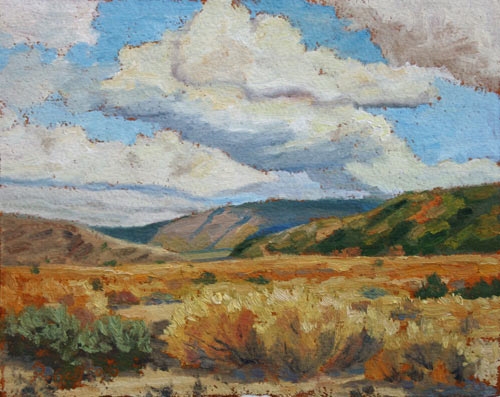
A case of mistaken identity has Richard Gallego painting on watercolor paper that’s been coated with shellac. He likes the results.
“I happened to be out painting in the desert, and this woman came by in a car and stopped because she thought I was an artist she knew,” says Gallego. “She had two large boxes of 300-lb watercolor paper in the back of the car that she had been carrying around for a year. ‘I don’t want to throw it away, but I want to get rid of it,’ she said.”

“When the Leaves Tell of Autumn,” by Richard Gallego, oil on prepared paper, 9 x 10 in.
These were nice, big, full sheets of good-quality, cold-pressed watercolor paper. Gallego cut up a few sheets into smaller pieces and painted on them in gouache. For oils, he generally paints on Raymar panels. But here was free support. Gallego worried about solvents and oil paints working their way through the paper’s sizing and degrading the paper, so he coated a few sheets, front and back, with acrylic gesso. But now the surface was a bit thirsty. The California artist remembered that one of his teachers used to paint on shellacked cardstock. Gallego coated the gessoed paper with a layer of orange, waxless shellac.

“High Desert Moonrise,” by Richard Gallego, oil on prepared paper, 6 x 10 in.
“The tooth is nice; it’s tacky,” reports Gallego. “I really like the way it takes the paint. The oil paint sits right on top, and the colors seem more vibrant. And a lot of what I paint is in warmer climates, like the desert, so I like the way it looks to have some of the warmth from the orange shellac show through.”

“Along Pallet Creek,” by Richard Gallego, oil on prepared paper, 6 x 6 in.
Gallego reports that his treated paper absorbs less paint and has more tooth than the oil-painting paper on the commercial market. He frames them with a foamcore backing.

“Land of Granite and Gold,” by Richard Gallego, oil on prepared paper, 9 x 10 in.
There could be archival issues: The layer of shellac can make the painting quite brittle, potentially flaking off along with the oil paint layers. But Gallego isn’t particularly worried about that. “I have some paintings on this surface that are a year old, and I’ve had zero problems,” he says. “Anyway, I don’t bend any of my paintings, including the ones done on this paper.”

“Under a Western Sky,” by Richard Gallego, oil on prepared paper, 7 x 9 in.
The painter also sometimes skips the gesso step and applies three coats of shellac on the paper, sealing the paper and possibly forming a stronger bond without the gesso in between. And this surface won’t replace his Raymar panels. “It’s just another surface I work on,” says Gallego.




